|
|
|
Sort Order |
|
|
|
Items / Page
|
|
|
|
|
|
|
| Srl | Item |
| 1 |
ID:
156519
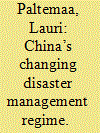

|
|
|
|
|
| Summary/Abstract |
This article analyses China’s disaster management regime at the local level. The article outlines historic disaster management regimes from the pre-imperial era to the present and ends with an analysis of the ongoing campaign for ‘comprehensive disaster relief model communities’. As argued in the article, throughout history Chinese disaster management has been characterized by attempts to combine strong state leadership with active grass-roots participation in disaster prevention and relief work, and different historical circumstances have translated into different kinds of disaster governance regimes with strengths and weaknesses. The current situation is no exception. The current model community drive led by the party-state aims to establish local professional or semi-professional disaster management organizations in every urban community, but leaves the role of civic organizations vaguely defined. While the state’s commitment to local-level disaster management has its strengths, the current ambiguous conceptualization of the role of civil society actors leaves resources untapped.
|
|
|
|
|
|
|
|
|
|
|
|
|
|
|
|
| 2 |
ID:
156521


|
|
|
|
|
| Summary/Abstract |
The devastating 2008 Wenchuan earthquake unfolded the co-evolution of a proactive civic engagement and extensive application of web-based information and communication technologies (ICTs) in China’s disaster response. However, existing literature has not yet sufficiently examined how ad hoc web-based voluntary participation has led to long-term development of digital disaster management in China in the wake of the Wenchuan earthquake of 2008. The present article addresses this gap by focusing on one specific type of ICT-mediated civic effort, crisis crowdsourcing, and presenting newly collected empirical evidence from relief work in the 2008 Wenchuan, 2010 Yushu, and 2013 Lushan earthquakes. This article examines the emergence of a broad-based digitally enabled civic participation in disaster response and its more general political implications. The main findings of this study suggest that web-based ICTs have not only enabled the relatively weak and episodic social actors to overcome constraints on information, fundraising, organizational development and to achieve collective development in a field historically dominated by the state, but also facilitated the evolution of a parallel disaster management system with agenda, skills and expertise independent of the state.
|
|
|
|
|
|
|
|
|
|
|
|
|
|
|
|
| 3 |
ID:
156524
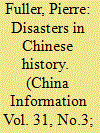

|
|
|
|
|
| Summary/Abstract |
Scholars in various disciplines have recognized that ‘natural’ disasters – and the extent to which natural hazards develop into humanitarian catastrophe – can reveal fundamental aspects of any particular government or society. What does history offer observers of disasters in contemporary China? What was the Chinese experience of environmental or natural disasters in pre-revolutionary or even premodern times? As recently as the early 2000s, the field of Chinese history offered little to answer such questions. Meanwhile, web searches remain the predominant avenue for non-academic researchers seeking historical contextualization, yet online searches on the vast majority of disasters in Chinese history continue to produce negligible results. With this in mind, a group of historians launched the website DisasterHistory.org in autumn 2015. Emerging now from its pilot stages, the site’s goals are to serve as an online introductory portal for academic studies and sources on Chinese disasters, to provide an accessible and reliable ‘go-to’ resource for academic researchers generally, and to create a forum for data-sharing and collaborative research for scholars across disciplines with shared interests in disasters, broadly defined.
|
|
|
|
|
|
|
|
|
|
|
|
|
|
|
|
| 4 |
ID:
156520
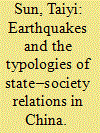

|
|
|
|
|
| Summary/Abstract |
The proliferation of civil society organizations after the 2008 Wenchuan earthquake and the 2013 Lushan earthquake in China has caught the attention of scholars in Chinese politics and disaster politics. Immediately after the earthquakes and during the recovery period, civil society organizations were given a rare opportunity to work closely and intensely with the state. As a result, these organizations adjusted their behaviour – sometimes compromising with the state on many fronts – in exchange for better relations with the state and in order to achieve their goals, but they had to work in new and creative ways. Drawing on evidence from a dozen case studies and 61 in-depth interviews with government officials and leaders of civil society organizations in Sichuan Province, this article argues that we can map the state’s preferences and policy distinctions through its varied responses to these organizations during an earthquake recovery period. Specifically, whether the state is more effective in delivering public goods and services in a given area and whether the goals of civil society organizations align with those of state are two key determinants of relations between the state and civil society organizations. This article proposes a comprehensive typology of such relations in China: complementary, cooperative, competitive and confrontational. These categories are not static, because the government and civil society organizations adjust their policies and behaviour as they interact. These learning experiences, triggered by the earthquakes, create a dynamic process of evolving state–society relations in China today.
|
|
|
|
|
|
|
|
|
|
|
|
|
|
|
|
| 5 |
ID:
156522
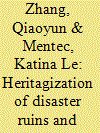

|
|
|
|
|
| Summary/Abstract |
This article discusses state-led heritagization processes in Beichuan and Wenchuan Counties, two Qiang ethnic minority areas severely affected by the 2008 Wenchuan earthquake (China). Certain destroyed landscapes were preserved and turned into earthquake relic sites. In particular, the former Beichuan County seat was entirely heritagized for memorial, economic, and patriotic education purposes, causing an emotional conflict with locals still affected by loss and trauma. At the same time, Qiang cultural practices were hastily registered as national and international intangible cultural heritage, while reconstructed Qiang villages were transformed into heritage tourism destinations. These initiatives tend to reshape Qiang culture elements into fetishized commodities. Allocating massive funds to historically marginalized regions, these post-disaster heritagization programmes aimed at boosting economic recovery, as well as demonstrating state power, national unity and solidarity. Implemented using a top–down method, they appear insensitive to the affected population’s trauma and the sociohistorical context from which the newly heritagized elements originate. The disaster and Qiang culture heritage tourism not only failed to bring about sustainable economic development to the earthquake-stricken areas, but also ignored to a large extent the initial goal of ‘post-disaster cultural recovery’ and the virtues of cultural heritage in recovery processes.
|
|
|
|
|
|
|
|
|
|
|
|
|
|
|
|
| 6 |
ID:
156518
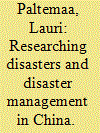

|
|
|
|
|
| Summary/Abstract |
This article offers an introduction to China Information’s special issue on disasters and disaster management. It is argued here that studying disasters and disaster management should not only improve our understanding of them as social phenomena and thereby increase our ability to manage disasters better, but also that disasters offer unique windows for researchers to study Chinese society and explain social and political changes therein. The article further argues that although research in natural disasters in China has developed rapidly both in terms of disciplinary approaches and topics, such research has still to overcome its narrow event-based nature and embrace more cross-disciplinary and comparative approaches geographically and historically, and disaster studies should investigate different types of disasters.
|
|
|
|
|
|
|
|
|
|
|
|
|
|
|
|
| 7 |
ID:
156523
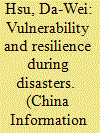

|
|
|
|
|
| Summary/Abstract |
The tendency of previous research on vulnerability and resilience is to measure these two factors as quantifiable variables that vary between social strata and social groups. Past findings often emphasize structural factors, such as inequality and power relations. My fieldwork on survivors of the 2008 Sichuan earthquake complements this paradigm in two steps. First, I display the ‘inter-’ and ‘intra-categorical’ variations of five social categories, each with its own advantages, limits, goals, and difficulties. The resilience of the survivors varies qualitatively and cannot be reduced to a unidimensional scale. Second, I develop a framework of resilience based on the degrees of structure and agency. I identify five modes of resilience: well-integrated, renouncing, activist, defeated, and treading water. This framework can be used to assess the resource distribution of a community, locate people in need and people who can contribute and design proper interventions.
|
|
|
|
|
|
|
|
|
|
|
|
|
|
|
|
|
|
|
|
|